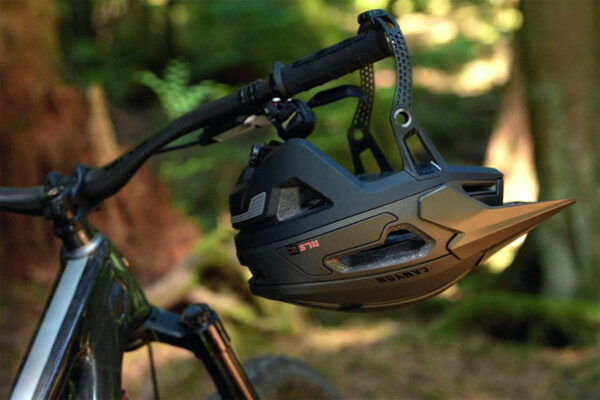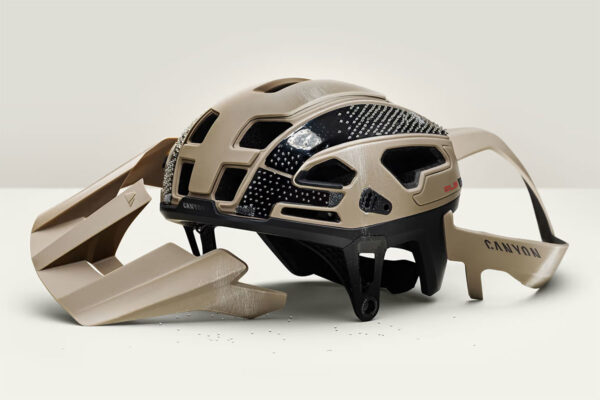Canyon Deflectr Trail Helmet – a load of balls

This new helmet is yet to be launched but is already rated number one for safety by Virginia Tech. How did it do it?
Introduction
Helmets. We all wear one and we all hope never to need one. Over recent years, new technologies have appeared to help reduce the risk of Traumatic Brain Injury (TBI).
I should know. I gave myself a concussion at Bike Park Wales, just about a year after Tony gave himself a concussion at… Bike Park Wales!
Other Moles have managed helmet-cracking impacts over the years. Just this August the Prof was thankful that his full face helmet saved his modelling career as we holidayed in the Alps.
Crashing is not big, or clever, but sometimes a crash helmet can save your day and your future.
Established technologies in crash helmet design now do much to avoid skull rotation in the event of impact. Most notable is MIPS (the yellow slip layer in many helmets), but other brands do similar with their own proprietary solutions.
Now there’s another to add to the list – the Release Layer System (RLS) that is being applied first to the helmet mentioned in this post’s title – the Canyon Deflectr trail helmet (that name! Just me or is it a bit like Defecator?).

What’s the Release Layer System?
Put simply, the Release Layer System is a layer of micro ball bearings made of plastic polycarbonate between the outer shell and the core of a crash helmet. The idea is that is allows the outer shell to move independently of the main helmet.
The shell itself is made of individual panels that eject on impact (or ‘flake off’ in my mind). This significantly reduces the rotational forces that act on the rider by something like 56-66%.
Thoughts?
I quite like the idea of this concept but would note a couple of things.
First, how much force dislodges the panels and once dislodged, is the rider looking for a new helmet or can they be replaced?
RLS – the company – say loose panels can be clipped back on, but I suspect the answer is… new helmet. Fine if it’s an impact, not fine if these things come loose while simply rolling around the back of a car.
Second, the impact clearly ejects some polycarbonate balls along with the panels in a video on the RLS site. Which is going to pollute the environment – either during the impact or at end of life disposal. So I’d like to know more about the green credentials/recyclability of this concept.
Oh and another thing – RLS estimate the technology adds about 45g to an RLS-equipped helmet (which is not nothing!).
Elsewhere, the Canyon Deflectr is yet to be launched and reviewed independently. I’ll be looking out for it as it looks an attractive helmet in its own right.
Every cyclist loves coffee!
☕Buy Matt a coffeeThere are 3 replies to Matt so far
We really appreciate comments from our readers. If you have something to say, we'd love to hear from you.

September 30, 2025 at 8:05 am
Tony says:
Excellent idea to reduce rotational forces. Good helmets are a must. My full face preserved my modelling career when I crashed and broke my collarbone (again) in the Alps last year. Airfix modelling career probably in my case..
, or add a new comment
October 3, 2025 at 3:10 pm
Will says:
My view having reviewed all the literature? Helmets are a 50-50 bet. They can both increase the chance of an impact (one scientific study says cars pass closer) and injury (the helmet increases head size by half, making an impact at low speed more likely).
A friend of a friend died because he was strangled by his helmet straps before a police officer could cut him free.
, or add a new comment
October 3, 2025 at 5:28 pm
Matt says:
Your friends sounds incredibly unlucky to be strangled by his helmet straps.
I think on the road the findings – particularly the injury one – are pretty mixed in the studies you refer to. People in the UK at least just hate cyclists.
I would still wear one simply because if you don’t and have an accident it’s an angle to exploit to suggest you had it coming to you in any investigation – even if its clearly not your fault and the car has driven over your legs (God forbid).
Off-road it’s imperative as the chance of impact greatly increases and anything that mitigates the severity is a good thing.
, or add a new comment